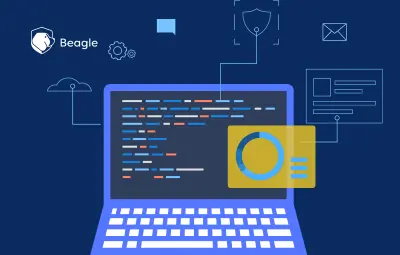
The OWASP Top 10, a globally recognized standard that shines a spotlight on the most critical mobile application security risks, serves as a guidepost for organizations and individuals striving to fortify their defenses against common threats.
In the era of ever-evolving cybersecurity, staying ahead of the curve is not just an advantage – it’s a necessity. Lurking beneath the sleek interfaces and intuitive features of our favorite apps lie potential vulnerabilities waiting to be exploited.
Improving software security is a crucial resource for anyone building or using mobile apps.
Each year, OWASP identifies the ten most critical security risks faced by the cyber world.
It serves as a roadmap for developers to prioritize vulnerabilities and strengthen their code, and for security professionals to assess the potential risks lurking within the applications.
In this blog, we embark on the 2024 OWASP top 10 vulnerabilities for mobile application considering a complete journey, delving into each security challenge to unravel its intricacies.
1. Improper credentials usage
The specter of threat agents exploiting hardcoded credentials and mishandling user credentials looms large these days.
These actors come armed with automated tools, be they publicly accessible or crafted for specific exploits- they scan and exploit hardcoded credentials or capitalize on vulnerabilities arising from improper credential usage.
How is improper credential usage exploited?
When improper handling of user credentials comes under the scrutiny of a potential attacker, a gateway to unauthorized access to sensitive functionalities within the mobile app swings open.
An attacker can exploit these predetermined access keys to infiltrate and navigate through the mobile application. This unauthorized access grants them entry into functionalities that are meant to be safeguarded.
What are the impacts of improper credentials?
Unauthorized Access to Sensitive Information and poor credential management opens the door for unauthorized users to gain access to sensitive information stored within the mobile app.
Data breaches and loss of privacy entrust mobile applications with one’s personal information. The fraudulent activities and adversaries equipped with improperly managed credentials can also engage in fraudulent activities within the mobile app.
How can improper credential usage be prevented?
First, eliminate the use of hardcoded credentials in your mobile application. These easily discoverable access keys create a vulnerable entry point for attackers.
Prioritize the secure management of user credentials throughout their lifecycle which includes encrypting credentials, avoid storing user credentials, implementing user authentication protocols etc.
2. Inadequate supply chain security
Inadequate supply chain security stands out as a critical concern. Exploiting vulnerabilities in the mobile app supply chain enables attackers to manipulate application functionality, posing a significant threat to the overall security of the system.
For example: Inadequate supply chain security in a mobile application could be an attacker compromising a third-party library used in the app. If the library is not regularly updated, and the developer fails to incorporate the latest security patches, it creates a vulnerability.
How is inadequate supply chain security exploited?
Inadequate supply chain security is exploited through various methods, often taking advantage of vulnerabilities introduced in the supply chain processes.
A threat actor has the potential to capitalize on vulnerabilities present in third-party libraries or components utilized within the application.
What are the impacts of inadequate supply chain security?
The impacts of inadequate supply chain security can be far-reaching and have serious consequences for an organization. It can lead to the compromise of software integrity, unauthorized access to sensitive data, leading to data breaches.
Disruptions in operations, affecting the availability and functionality of software or hardware products along with the compromise of the entire supply chain ecosystem.
How can you prevent inadequate supply chain security?
Vendor assessment: Conduct thorough assessments of vendors and third-party suppliers before engaging in partnerships.
Secure development Practices: Implement secure coding practices and conduct regular security reviews during the development phase.
Employ encrypted communication channels throughout the supply chain to protect data during transit and implement continuous monitoring mechanisms to detect and respond to security incidents promptly.
3. Insecure authentication authorization
Malicious actors exploiting authentication and authorization vulnerabilities commonly employ automated attacks, utilizing either readily available or custom-crafted tools.
This includes issues like weak authentication, flawed authorization controls, insecure session management, and inadequate credential storage. Addressing these concerns is crucial for ensuring robust mobile app security.
How is insecure authentication authorization exploited?
When a threat is identified vulnerabilities in either the authentication or authorization framework, they can exploit these weaknesses in two distinct manners.
They might falsify or bypass authentication by directly submitting service requests to the backend server of the mobile app, avoiding any direct engagement with the app.
They can even log into the application as a legitimate user after passing authentication controls and then navigate to a vulnerable endpoint to execute administrative functionality.
What are the impacts of insecure authentication authorization
Unauthorized access: Attackers can gain unauthorized access to sensitive data, user accounts, or restricted functionalities within the mobile app.
Identity theft: Exploiting authentication vulnerabilities can enable identity theft, allowing attackers to impersonate legitimate users.
Financial loss: Insecure authentication may lead to unauthorized financial transactions or fraudulent activities, resulting in financial losses for both users and the app provider.
How can you prevent insecure authentication authorization
Ensure that the authentication requirements for mobile applications align with those of the web application component.
On jailbroken devices, the authentication routine of the application can be circumvented through runtime manipulation or binary modification if the app stores data locally.
Backend systems must autonomously validate the roles and permissions assigned to authenticated users. Do not depend on role or permission data originating from the mobile device.
4. Insufficient input/output validation
Inadequate validation and sanitization of data sourced externally, like user inputs or network data, pose significant security threats to mobile applications.
Apps lacking proper validation and sanitization measures become susceptible to exploitation through mobile-specific attacks, including SQL injection, Command Injection, and cross-site scripting (XSS) attacks.
How is an insufficient input/output validation exploited
Inadequate input/output validation opens our application to severe attack vectors, such as SQL injection, XSS, command injection, and path traversal. These vulnerabilities may result in unauthorized access, data manipulation, code execution, and compromise of the entire backend system.
What are the impacts of insufficient input/output validation
This vulnerability can be exploited by attackers to execute unauthorized code, potentially resulting in system compromise and unauthorized access. Insufficient validation enables attackers to manipulate input, leading to data breaches and unauthorized access to sensitive information.
How can you prevent the impact of insufficient input/output validation?
implement strict validation rules: Enforce rigorous input validation rules to ensure that data from external sources.
Use whitelisting: Employ whitelisting techniques to allow only approved characters and patterns, rejecting any input that doesn’t conform to the established criteria.
Sanitize user inputs: Implement thorough data sanitization for user inputs to remove any malicious content or characters that could lead to vulnerabilities like XSS attacks.
Avoid trusting client-side data: Do not solely rely on data validation performed on the client side, as it can be manipulated.
5. Insecure communication
Many contemporary mobile applications interact with remote servers for data exchange. During data transmission, which often traverses the mobile device’s carrier network and the internet, there is a risk of interception and modification by a threat agent if the data is transmitted without encryption or relies on outdated encryption protocols.
This insecurity in communication can expose sensitive information to potential threats. Common issues include the lack of encryption, weak encryption protocols, or improper implementation of secure communication channels.
How is insecure communication exploited?
Attackers may use packet sniffing tools to intercept and analyze data packets traveling over the network. If the communication is not encrypted, the attacker can easily read the sensitive information.
In a MitM attack an attacker positions themselves between the mobile device and the server, intercepting and possibly modifying the communication.
Utilizing outdated protocols or improperly configured settings, such as accepting basic SSL certificates.
What are the impacts of insecure communication
The immediate impacts of insecure communication include identity theft, fraudulent activities and reputational damage.
Data breaches: Insecure communication channels can lead to unauthorized access to sensitive data, resulting in data breaches.
Compromised privacy: Insecure communication can violate individuals’ privacy by exposing personal or confidential information.
Financial losses: Security breaches resulting from insecure communication can lead to financial losses through theft, fraud, or extortion.
How can you prevent insecure communication
Use secure protocols: Employ strong encryption protocols such as TLS (Transport Layer Security) for securing data in transit.
Implement HTTPS: Ensure that all communication between the mobile app and servers occurs over HTTPS. This guarantee encrypted and secure data transmission.
Certificate validation: Implement rigorous validation checks for SSL/TLS certificates. Reject self-signed, expired, revoked, or incorrectly configured certificates to thwart potential attacks.
Secure configuration: Configure servers and communication settings securely. Follow best practices for cipher suites, key lengths, and other parameters to enhance overall security.
6. Inadequate privacy control
This could involve insufficient safeguards for sensitive user data, inadequate consent mechanisms, or weak controls over the collection, storage, or sharing of personal information.
This vulnerability exposes users to potential privacy breaches, unauthorized access to personal data, or misuse of sensitive information.
How is inadequate privacy control exploited
Common sources of Personally Identifiable Information (PII) within mobile applications, such as the app’s sandbox, network communication, logs, and backups, are typically well-protected.
Some sources, like URL query parameters and clipboard content, have less stringent protection but are still challenging to access.
For an attacker to obtain PII, they would need to breach security at another level. This could involve eavesdropping on network communication, accessing the file system, clipboard, or logs using a trojan, or physically obtaining the mobile device to create a backup for analysis. PII, being data that can be stored, processed, and transmitted through various means on mobile devices, presents diverse opportunities for extraction or manipulation.
What are the impacts of inadequate privacy control
Unauthorized access: Weak privacy controls may result in unauthorized access to sensitive user data
Data misuse: Inadequate privacy measures increase the risk of data misuse, where personal information may be exploited for malicious purposes
Legal consequences: In many jurisdictions, privacy regulations mandate strict controls over user data.
Financial implications: Privacy breaches may result in financial losses, not only due to potential legal penalties but also through the costs associated with remediation, customer compensation, and damage control.
How can you prevent inadequate privacy control?
Use strong encryption methods to safeguard sensitive user data, both during storage and transmission. Secure storage practice mechanisms for sensitive information, ensure that user data is stored in an encrypted and protected manner.
Clearly communicate privacy policies to users, detailing how their data will be collected, processed, and stored.
Conduct regular security audits and assessments to identify and address potential privacy vulnerabilities.
7. Insufficient binary protection
The binary may include valuable information, such as commercial API keys or hardcoded cryptographic secrets that could be exploited by an attacker. The code within the binary might be valuable independently, containing critical business logic or pre-trained AI models.
Certain attackers may not directly target the app but use it to probe potential vulnerabilities in the associated backend, preparing for a future attack.
How can you exploit insufficient binary protection
Reverse engineering: Reverse engineering involves decompiling the app binary to search for valuable information such as secret keys, algorithms, or vulnerabilities.
Code tampering: Code tampering refers to manipulating the app binary, for instance, removing license checks, bypassing paywalls, or gaining user benefits. Impact
Secret key exposure: Attackers may exploit vulnerabilities in the unprotected binary to extract sensitive information, such as secret keys or cryptographic secrets, compromising the security of the application and associated services.
Algorithm exposure: Inadequate protection may lead to the exposure of proprietary algorithms or logic embedded in the binary, providing valuable insights to competitors or malicious actors seeking to replicate or exploit the app’s functionality.
How can you prevent insufficient binary protection
Apply code obfuscation techniques to make the binary code more challenging to understand and reverse engineer. This helps protect sensitive information and proprietary logic. Encrypt critical components of the binary, such as secret keys and algorithms, to make it more difficult for attackers to extract valuable information during reverse engineering.
You can also implement tamper detection mechanisms to identify unauthorized modifications to the binary. This can include checksums, digital signatures, or integrity checks to ensure the binary’s integrity.
Integrate RASP solutions that provide real-time monitoring and protection against runtime attacks, including those targeting the binary.
8. Security misconfiguration
Security misconfigurations in mobile apps can manifest in various forms, including inadequate authentication mechanisms, overly permissive permissions, and improperly configured access controls.
These misconfigurations may result in unintended exposure of sensitive information, unauthorized access to certain functionalities, or exploitation by malicious actors.
Identifying and addressing security misconfigurations is crucial for maintaining a robust defense against potential security threats and ensuring the overall security posture of mobile applications.
How is security misconfiguration exploited?
Mobile applications frequently have default configurations with weak security settings or unnecessary permissions enabled, creating vulnerabilities that can be exploited in attacks. Improperly configured access controls may permit unauthorized users to access sensitive data or execute privileged actions within the mobile app.
Implementation of weak or improperly configured encryption and hashing algorithms poses a risk, allowing attackers to exploit vulnerabilities and gain unauthorized access to sensitive information.
What are the impacts of security misconfiguration?
Unauthorized access: Malicious actors may exploit misconfigured authentication mechanisms to gain access to sensitive areas or data within the mobile app.
Data exposure: Improperly configured permissions and access controls might lead to unintended exposure of sensitive information,
Abuse of features: Attackers may misuse misconfigured features or settings to carry out actions that were not intended by the app’s developers, leading to potential abuse of functionality.
Denial of Service (DoS): Misconfigurations could be exploited to launch denial-of-service attacks, disrupting the normal operation of the mobile app and affecting its availability to users.
How can you prevent security misconfiguration?
Preventing exploitation of security misconfigurations involves implementing secure coding practices, conducting regular security assessments, and following industry best practices for secure configuration. Continuous monitoring and prompt remediation of misconfigurations are crucial to maintaining a robust defense against potential exploitation and ensuring the security of mobile applications.
9. Insecure data storage
Insecure data storage within a mobile application can be a magnet for various threat actors seeking to exploit vulnerabilities and gain unauthorized access to sensitive information.
These actors encompass skilled adversaries targeting mobile apps for data extraction, malicious insiders within the organization or app development team abusing their privileges, state-sponsored actors engaging in cyber espionage, cybercriminals pursuing financial gains through data theft or ransom, script kiddies employing pre-built tools for straightforward attacks etc.
How is insecure data storage exploited?
Vulnerabilities in insecure data storage within a mobile application open door to a range of attack vectors exploitable by threat actors. These vectors encompass unauthorized access to the device’s file system, achieved through physical or remote means, the exploitation of weak or nonexistent encryption, interception of data transmissions, and the utilization of malware or malicious apps installed on the device.
Furthermore, rooted or jailbroken devices create an avenue for attackers to circumvent security measures and directly access sensitive data. Additional attack vectors involve social engineering techniques to deceive users, either by manipulating their access to data or influencing the application’s behavior.
What are the impacts of insecure data storage?
Unauthorized access: Attackers can gain unauthorized access to sensitive user data stored within the application, leading to privacy breaches.
Data manipulation: Insecure data storage allows for the manipulation or tampering of stored information, potentially leading to false or misleading data.
Financial loss: Insecure data storage can result in financial losses for both users and the organization behind the application, especially if financial or payment-related information is compromised.
Reputation damage: Security incidents involving data breaches can tarnish the reputation of the mobile application and the organization, eroding user trust.
How can you prevent insecure data storage
Implement strong encryption algorithms to protect sensitive data stored on the device. Ensure that data is encrypted both in transit and at rest. Safely manage cryptographic keys used for encryption to prevent unauthorized access to the stored data.
Also enforce strict access controls, ensuring that only authorized users and components have access to sensitive data. Use role-based access control (RBAC) mechanisms.
Utilize secure communication protocols (e.g., SSL/TLS) when transmitting data between the mobile app and servers to prevent eavesdropping.
By implementing a security strategy that addresses both storage misconfigurations and third-party library vulnerabilities, you can significantly reduce the risk of insecure data storage and enhance the overall security posture of your applications and systems.
Apply the principle of least privilege to ensure that users and services have the minimum necessary permissions to access and modify data. Keep third-party libraries and dependencies up to date with the latest security patches.
Regularly review and update your application’s dependencies to patch any known vulnerabilities.
10. Insufficient cryptography
Threat actors exploiting insecure cryptography in mobile applications pose a risk to the confidentiality, integrity, and authenticity of sensitive information.
These actors encompass attackers targeting cryptographic algorithms or implementations to decipher sensitive data, malicious insiders manipulating cryptographic processes or divulging encryption keys, state-sponsored actors conducting cryptanalysis for intelligence purposes, cybercriminals exploiting weak encryption for data theft or financial fraud, and attackers leveraging vulnerabilities in cryptographic protocols or libraries.
How is insufficient cryptography exploitation
The attack vector associated with insecure cryptography in a mobile application revolves around exploiting vulnerabilities within the cryptographic mechanisms employed to safeguard sensitive information.
By focusing on insecure cryptography, attackers seek to decrypt encrypted data, manipulate cryptographic processes, or attain unauthorized access to sensitive information.
What are the impacts of insufficient cryptography
Data breaches: Adversaries exploiting insecure cryptography may lead to the compromise of encrypted data, resulting in data breaches and the exposure of sensitive information.
Unauthorized access: Weak cryptographic mechanisms can allow attackers to gain unauthorized access to user accounts, compromising the confidentiality of personal and sensitive data.
Compromised confidentiality: Insecure cryptography undermines the confidentiality of sensitive information, as adversaries may successfully decrypt protected data.
Data manipulation: Attackers exploiting vulnerabilities in cryptographic processes may manipulate or tamper with data, leading to the potential distortion or falsification of information.
How can you prevent insufficient cryptography?
Use strong encryption algorithms: Employ robust and widely accepted encryption algorithms to protect sensitive data, avoiding deprecated or weak cryptographic methods.
Implement key management best practices: Adhere to secure key management practices, including regular key rotation, secure storage of keys, and protection against unauthorized access.
Regular security audits: Conduct regular security audits and assessments to identify and address vulnerabilities in the cryptographic implementation, ensuring its resilience against potential attacks.
Stay informed about cryptographic Best Practices: Keep abreast of cryptographic best practices and industry standards to incorporate the latest security measures into the application.
Summing up
Understanding and addressing the OWASP Top 10 Mobile Application Vulnerabilities is paramount in ensuring the security and integrity of mobile applications.
By staying vigilant against threats like insecure data storage, inadequate authentication, and insufficient input validation, developers and organizations can fortify their mobile apps against potential exploits.
Implementing strong security measures, staying informed about emerging threats, and fostering a security-first mindset are crucial steps in safeguarding mobile applications and the sensitive data they handle.
As technology evolves, a proactive approach to mobile application security will remain essential in building trust, protecting users, and maintaining the resilience of digital ecosystems.








